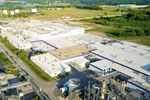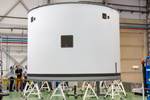Toray supplies Torayca carbon fiber, prepreg for H3 launch vehicle
Set to launch Feb. 15, the Japan Aerospace Exploration Agency rocket has been designed with a composite motor case and payload fairing section.
Artist’s illustration of the H3 launch vehicle. Photo Credit: Toray Industries, JAXA
Toray Industries (Tokyo, Japan) announces that it has supplied the Japan Aerospace Exploration Agency’s (JAXA, Tokyo) H3 launch vehicle — the successor to its H-IIA rocket — with Torayca carbon fiber and prepreg. As it was used in H-IIA, the carbon fiber has been implemented in the H3 motor case (the part of the rocket body that stores solid fuel and serves as the combustion chamber) and Torayca prepreg, designed using high-strength carbon fiber and high-toughness resin, has been newly adopted for the payload fairing section (the leading edge of the launch vehicle where satellites and other payloads are loaded).
The is JAXA’s new flagship launch vehicle aiming at achieving high flexibility, high reliability and high cost performance. The rocket is 63 meters high with a diameter of 5.2 meters. According to the , the rocket is “capable of delivering ‘4 tons or more’ to a 310-mile-high (500 kilometers) sun-synchronous orbit and ‘6.5 tons or more’ to geostationary transfer orbit. JAXA has planned the H3’s launch for Feb. 15, 2023.
Torayca prepreg, used in fairings, is a slit tape prepreg designed for the automated fiber placement (AFP) process, enabling efficient forming and processing of complex shapes and large structural materials, including oven forming, in addition to conventional autoclave forming.
In recent years, Toray notes that the use of satellites has expanded in various fields such as broadcasting, communications, positioning (GPS), Earth observation and disaster prevention, and the demand for launch vehicles has been increasing year by year. With the demand for lower launch costs and higher performance, the use of composite materials is expected to expand further in the future. Toray will continue to support such demand with Torayca products.
Related Content
-
Co-molding SMC with braided glass fiber demonstrates truck bed potential
Prepreg co-molding compound by IDI Composites International and A&P Technology enables new geometries and levels of strength and resiliency for automotive, mobility.
-
Low-cost, efficient CFRP anisogrid lattice structures
CIRA uses patented parallel winding, dry fiber, silicone tooling and resin infusion to cut labor for lightweight, heavily loaded space applications.
-
Composites end markets: New space (2025)
Composite materials — with their unmatched strength-to-weight ratio, durability in extreme environments and design versatility — are at the heart of innovations in satellites, propulsion systems and lunar exploration vehicles, propelling the space economy toward a $1.8 trillion future.



